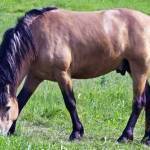Outcomes for Horses with Equine Herpesvirus Myeloencephalopathy Differ

In 2021, an equine herpesvirus (EHV) outbreak erupted at an international jumping event in Valencia, Spain. Horses with the neurologic form of the disease (equine herpesvirus myeloencephalopathy or EHM) had a 53% chance of returning to a similar or better level of performance.* That is, if they survive the initial phase of the disease.
EHV-1 causes EHM with affected horses showing incoordination due to inflammatory damage to nervous tissue.
“Competition horses have an increased risk of EHV-1 due to the increased movement of horses during shows, transport-related stress, and temporary housing with decreased ventilation, among other factors,” explained Ashley Fowler, Ph.D., a nutritionist for Kentucky Equine Research. “This highlights the need for strict biosecurity at competitions and monitoring upon returning home.”
Treating horses with EHM is time-consuming, expensive, and has important welfare implications. Therefore, knowing the outcomes of horses that recover from EHM is relevant.
In total, 26 horses were hospitalized at a single veterinary facility and treated during the 2021 outbreak. The overall case fatality rate was 31%. But, if horses had an ataxia grade of 4 or more out of 5, or developed urinary complications or vasculitis (e.g., limb swelling), there was a decreased chance of survival. Horses with severe ataxia (grade 4 or more out of 5) had a 60% chance of returning to exercise but only a 10% chance of a full recovery (returning to pre-outbreak performance levels).
None of the horses with a combination of vascular and urinary complications and severe ataxia returned to previous levels of performance.
Horses were treated according to the published EHM recommendations, which included corticosteroids, and most horses also underwent physical rehabilitation. This included:
- Proprioception exercises;
- Core work; and
- Neuromuscular electrical stimulation.
“Adequate vitamin E is essential for preventing oxidative damage and supporting a healthy neuromuscular system. A water-soluble, natural vitamin E such as Nano-E is the most bioavailable form and is recommended by veterinarians for horses with neurological diseases,” shared Fowler.
*de la Cuesta-Torrado, M., A. Velloso Alvarez, P. Neira-Egea, and J. Cuervo-Arango. 2024. Long-term performance of show-jumping horses and relationship with severity of ataxia and complications associated with myeloencephalopathy caused by equine herpes virus-1. Journal of Veterinary Internal Medicine 38(3):1799-1807.







